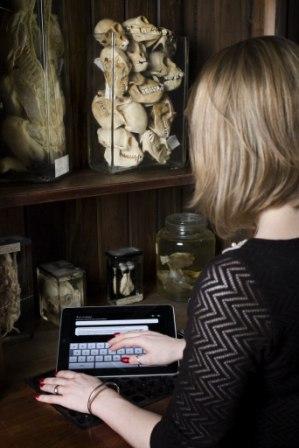Animals and iPads: QRator in the Grant Museum
By Claire S Ross, on 16 March 2011

UCL, Grant Museum of Zoology / Matt Clayton
UCL’s Grant Museum of Zoology reopened yesterday (15 March), it houses around 67,000 specimens, covering the whole Animal Kingdom alongside some of the rarest extinct animal specimens in the world to be displayed for the first time, including lost dodo bones, the remains of a quagga (an extinct species of half-striped zebra) and a giant Irish elk with antlers measuring nearly 3 metres across. In contrast to the more traditional museum outlook, crammed full of specimens, the new Grant has integrated iPads, QRCodes and Twitter into the mix via a UCLDH and CASA project known as QRator. The aim of which is to stress the necessity of engaging visitors actively in the creation of their own interpretations of museum collections, and whether this can be done seamlessly through digital technology.
Through the QRator project the Grant Museum is experimenting with ways of using a natural history collection as a starting point for questions about science. Alongside displays of stuffed chimpanzees, and pickled animal parts, iPads are scattered, asking provocative questions about the ways museums operate, and the role of science in society. QRator encourages visitors to tackle big questions in the life sciences and engage with the way museums work. Questions include “Should human and animal remains be treated any differently?” And “every medicinal drug you have ever taken was tested on animals. Is this a necessary evil?” Each iPad holds a current question which visitors can respond to on the iPad itself, via Twitter or the Tales of Things app on their smart phones. Visitors’ thoughts become part of the museum objects history and the display itself creating digital ‘living’ labels which subsequent visitors can read and respond to in real time.
QRator has been a very exciting project, and we are very proud of it. It is picking up quite a bit of media attention:
- Home of dodo pelvises and quagga bones spreads its wings – New Scientist
- Museums: Campus treasures – Nature
- Pickled Moles And iPads: Grant Museum Set To Reopen – Londonist
- UCL’s Grant Museum of Zoology to reopen – Wired
- Dodo bones discovery adds life to museum’s opening – The Evening Standard
- Half a dodo found in museum drawer – The Guardian
- In Pictures: University College London’s Grant Museum of Zoology gets ready for reopening – Culture24
- Extinct creatures on display at Grant Museum of Zoology – BBC Science
Throughout the project we have tried to be as user centred as possible, undertaking user requirements gathering and user evaluation every step of the way. Now that the iPads have been installed into the Grant, visits to the museum will be observed to discover how visitors interact and engage with the content. It is frequently voiced that visitors do not read labels; it will be interesting to observe if this is still the case when the visitors themselves are able to create and interact with the interpretive content.
We will be continuing to do user testing on QRator for the next few months to see what people really think. So if you are interested in being involved, do let us know! If you would like to take part in the evaluation or would like further information, please contact Claire Ross directly. All feedback received will help shape the future development of QRator as it continues to explore increasing digital access and engagement with museum collections.
One Response to “Animals and iPads: QRator in the Grant Museum”
- 1
 Close
Close


[…] UCL Centre for Digital Humanities » Blog Archive » Animals and iPads: QRator in the Grant Museum. […]